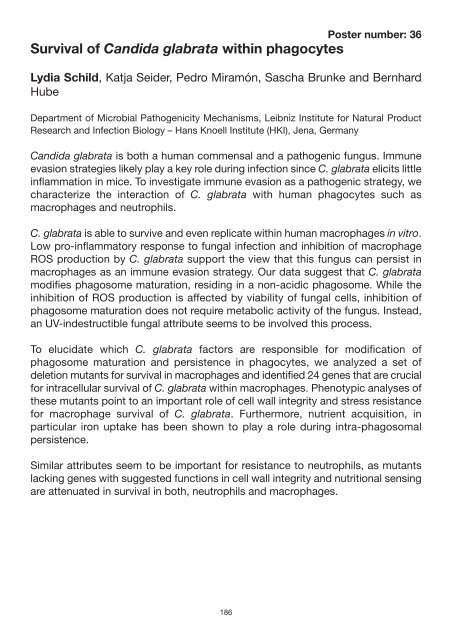Candida Infection Biology – fungal armoury, battlefields ... - FINSysB
Candida Infection Biology – fungal armoury, battlefields ... - FINSysB
Candida Infection Biology – fungal armoury, battlefields ... - FINSysB
Create successful ePaper yourself
Turn your PDF publications into a flip-book with our unique Google optimized e-Paper software.
Poster number: 36<br />
Survival of <strong>Candida</strong> glabrata within phagocytes<br />
Lydia Schild, Katja Seider, Pedro Miramón, Sascha Brunke and Bernhard<br />
Hube<br />
Department of Microbial Pathogenicity Mechanisms, Leibniz Institute for Natural Product<br />
Research and <strong>Infection</strong> <strong>Biology</strong> – Hans Knoell Institute (HKI), Jena, Germany<br />
<strong>Candida</strong> glabrata is both a human commensal and a pathogenic fungus. Immune<br />
evasion strategies likely play a key role during infection since C. glabrata elicits little<br />
inflammation in mice. To investigate immune evasion as a pathogenic strategy, we<br />
characterize the interaction of C. glabrata with human phagocytes such as<br />
macrophages and neutrophils.<br />
C. glabrata is able to survive and even replicate within human macrophages in vitro.<br />
Low pro-inflammatory response to <strong>fungal</strong> infection and inhibition of macrophage<br />
ROS production by C. glabrata support the view that this fungus can persist in<br />
macrophages as an immune evasion strategy. Our data suggest that C. glabrata<br />
modifies phagosome maturation, residing in a non-acidic phagosome. While the<br />
inhibition of ROS production is affected by viability of <strong>fungal</strong> cells, inhibition of<br />
phagosome maturation does not require metabolic activity of the fungus. Instead,<br />
an UV-indestructible <strong>fungal</strong> attribute seems to be involved this process.<br />
To elucidate which C. glabrata factors are responsible for modification of<br />
phagosome maturation and persistence in phagocytes, we analyzed a set of<br />
deletion mutants for survival in macrophages and identified 24 genes that are crucial<br />
for intracellular survival of C. glabrata within macrophages. Phenotypic analyses of<br />
these mutants point to an important role of cell wall integrity and stress resistance<br />
for macrophage survival of C. glabrata. Furthermore, nutrient acquisition, in<br />
particular iron uptake has been shown to play a role during intra-phagosomal<br />
persistence.<br />
Similar attributes seem to be important for resistance to neutrophils, as mutants<br />
lacking genes with suggested functions in cell wall integrity and nutritional sensing<br />
are attenuated in survival in both, neutrophils and macrophages.<br />
186


